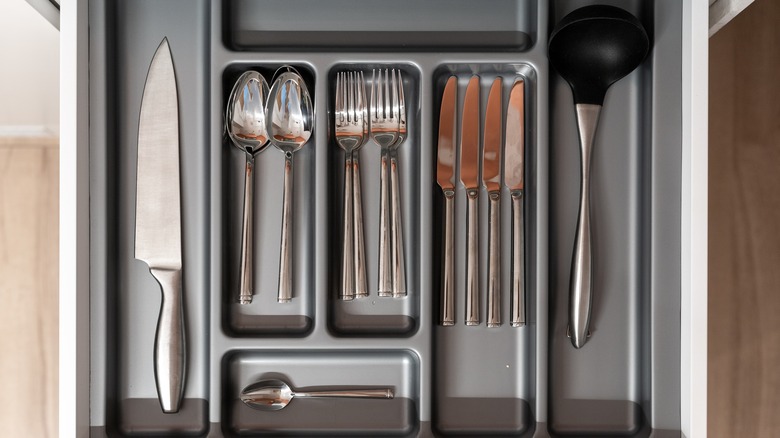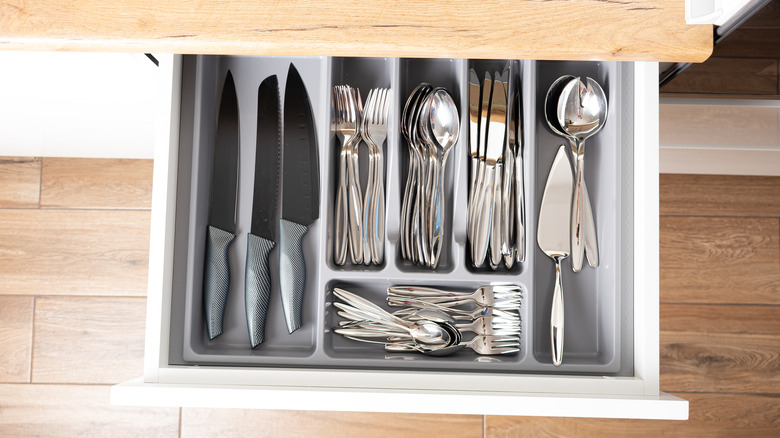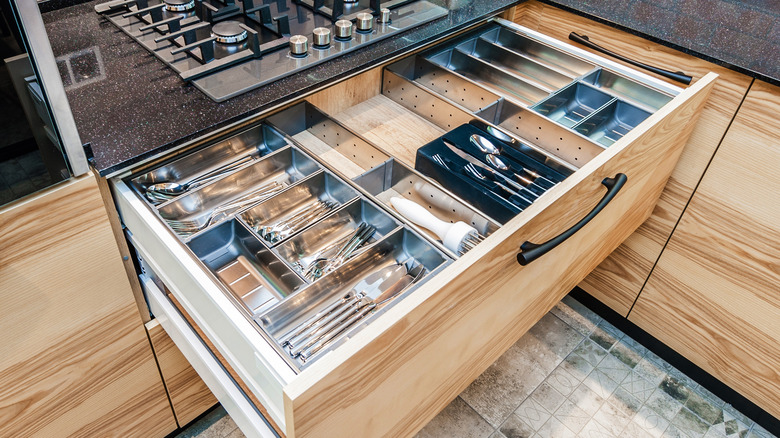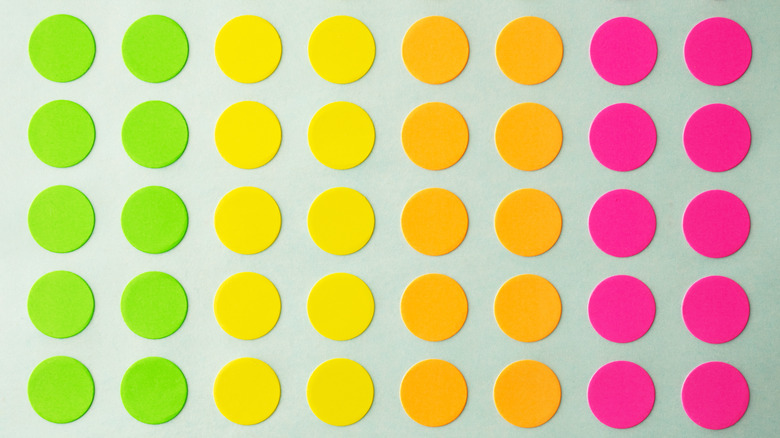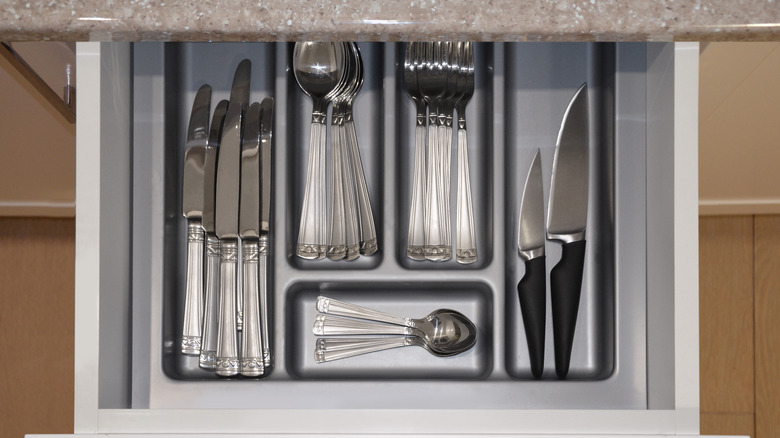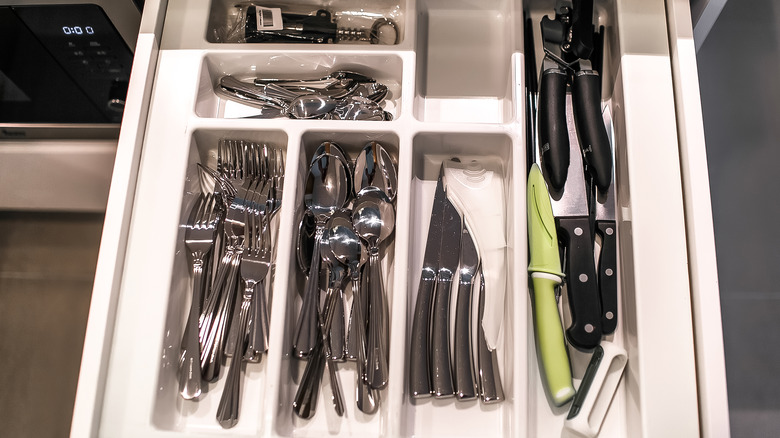Don't Make These Common Mistakes When Organizing Your Silverware Drawer
We may receive a commission on purchases made from links.
Your kitchen is one of the most important rooms in your home to keep organized. A messy, cluttered kitchen is a recipe for chaos — no one wants to dig for their vegetable peeler or knife sharpener while their food is on the verge of burning. This not only makes cooking a lot less stressful but safer, too. Auguste Escoffier School of Culinary Arts explains that an organized, clutter-free kitchen lessens the risk of cuts, burns, or other dangerous kitchen mishaps.
This doesn't just apply to your pantry, fridge, pots, and pans but your utensils and silverware. Specifically, your silverware drawer. Opening your silverware drawer in search of a fork, spoon, or kitchen tool, only to be greeted by a mess of jumbled metal, is incredibly frustrating. Despite your best efforts, it may feel like your drawer never stays organized. Keep reading to make sure you're not making these common silverware drawer organization mistakes.
1. Not using an organizer
The first and most obvious mistake you could make when arranging your silverware drawer is not using a drawer organizer. Even if you have a small drawer or a small number of utensils, you must have this. Otherwise, you're left with a haphazard pile of various-sized spoons and forks. If you have knives in the mix, you also risk accidentally cutting yourself.
Not having a silverware organizer also means your utensils take up unnecessary volume in the drawer. Without a functional organizer, your silverware will pile on top of itself instead of stacking or slotting like it's designed. With an organizer, you can create distinct categories and stack your utensils, which creates more space overall, via EdgeWood Cabinetry. Depending on the model, you may be shocked that adding a drawer organizer or divider can fit even more silverware and other small kitchen tools than previously thought.
2. Only using one divider
A large or oddly shaped silverware drawer is no excuse for not using an organizer. Ideally, every inch of your silverware drawer should have some organizer or divider, which allows you to designate a spot for less common utensils like spatulas, knife sharpeners, peelers, etc., without them getting lost in a disorderly pile.
The Container Store recommends using an expandable drawer organizer for larger but regularly shaped drawers. These will stretch to cover the width of most drawers or shrink for smaller spaces. Consider taking a modular approach if you have an oddly shaped drawer or one too big for an expandable organizer. This can mean adding a drawer divider to fill up the back and side of your drawers in combination with a regular organizer or just using multiple small dividers for each item. Pay extra attention to filling the gap behind your organizer, so things don't accidentally get shoved back and forgotten about.
3. Not sticking down your divider
If your drawer isn't packed with organizers or dividers, you could face the issue that the ones you do have slide around a lot. Besides being annoying, this is one of the ways utensils that are not in an organizer slide around and get misplaced. Many of these organizational tools have rubber stoppers on the bottom. Still, if they don't, the acrylic, plastic, wood, or metal are very likely to shuffle around every time you open or close your drawer.
This is why Organized-ish recommends sticking your containers down to the surface of your drawer. Start by completely emptying the drawer, and then clean it thoroughly. Next, lay out each divider. Once you have a layout you like, use something to stick them down. You'll preferably want something that won't permanently alter the drawer or leave a tough-to-clean sticky residue behind. Consider using museum gel, which avoids both of those problems.
4. Arranging utensils incorrectly
A drawer organizer is nearly pointless if you throw your utensils in without a care. While there is no one right way to use an organizer, some methods are undoubtedly better than others. Organized-ish notes that most organizers have five slots, which correspond directly with the five types of utensils sold in a kit — large and small spoons, large and small forks, and butter knives.
However, you may have a more prominent organizer or smaller utensil collection that leaves you with extra slots. Don't try to fit oversized utensils in these. Instead, add slim, smaller miscellaneous utensils like reusable straws, chopsticks, smaller coffee or teaspoons, salad serving utensils, corn holders, etc. From there, use your larger dividers to store and organize bigger utensils neatly, like kitchen scissors, measuring cups and spoons, vegetable peelers, zesters, citrus squeezers, garlic presses, and so on. Essentially, utensils are too small to fit in an upright countertop holder but too large to include in your regular organizer.
5. Shoving too much in
The last mistake you could make when organizing your silverware is trying to fit too much in. While organizers help, they can only do so much. You should prioritize your basics — spoons, forks, knives, miscellaneous kitchen tools — and reallocate larger tools like immersion blenders, large sharpeners, sifters, and so on to other areas of your kitchen.
One option to get these miscellaneous, random objects organized is to create a second utensil organization drawer, recommends Fox Hollow Cottage. If you don't have any extra drawer space to spare, you could also store these objects on your kitchen counter. Get a round, metal, or ceramic utensil holder, show them off on a display tray, or get creative and store them in a basket. Organized-ish suggests using long and thin plastic or glass food storage containers, which can be conveniently tucked away into your kitchen cupboards or a dining room hutch.
